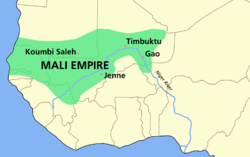Malian Empire
| Mali Empire | ||||||||||||||||||
|
Nyeni (Bambara) after c. 1230: Mande Kurufaba (Bambara) |
||||||||||||||||||
|
||||||||||||||||||
|
Extent of the Mali Empire (c. 1350)
|
||||||||||||||||||
| Capital | Niani; later Ka-ba | |||||||||||||||||
| Languages | Malinké, Mandinka, Fulani, Bozo | |||||||||||||||||
| Religion | African Traditional Religion, Islam | |||||||||||||||||
| Political structure | Empire | |||||||||||||||||
| Mansa (Emperor) | ||||||||||||||||||
| • | 1235–1255 | Mari Djata I (first) | ||||||||||||||||
| • | c. 17th century | Mahmud IV (last) | ||||||||||||||||
| Legislature | Gbara | |||||||||||||||||
| Historical era | Postclassical Era | |||||||||||||||||
| • | Established | c. 1235 | ||||||||||||||||
| • | Capital moved from Niani to Kangaba | 1559 | ||||||||||||||||
| • | State collapses and divided among emperor's sons | c. 1610 | ||||||||||||||||
| Area | ||||||||||||||||||
| • | 1250 | 100,000 km² (38,610 sq mi) | ||||||||||||||||
| • | 1312 | 1,294,994 km² (500,000 sq mi) | ||||||||||||||||
| • | 1380 | 1,100,000 km² (424,712 sq mi) | ||||||||||||||||
| • | 1500 | 400,000 km² (154,441 sq mi) | ||||||||||||||||
| Currency |
Gold dust (Salt, copper and cowries were also common in the empire) |
|||||||||||||||||
|
||||||||||||||||||
| Today part of |
|
|||||||||||||||||
| National Symbol: Falcon Sacred Animal:Falcon and numerous other animals according to each of the governing clans (Lion etc.) |
||||||||||||||||||
The Mali Empire (Manding: Nyeni;English: Niani; also historically referred to as the Manden Kurufaba, sometimes shortened to Manden) was an empire in West Africa from c. 1230 to c. 1610. The empire was founded by Sundiata Keita and became renowned for the wealth of its rulers, especially Musa Keita. The Manding languages were spoken in the empire. It was the largest empire in West Africa and profoundly influenced the culture of West Africa through the spread of its language, laws and customs.
Much of the recorded information about the Mali Empire comes from the 14th century North African Arab historian Ibn Khaldun, the 14th century Moroccan traveller Ibn Battuta and the 16th century Moroccan traveller Leo Africanus. The other major source of information is Mandinka oral tradition, through storytellers known as griots.
The empire began as a small Mandinka kingdom at the upper reaches of the Niger River, centred around the town of Niani (the empire's namesake in Manding). During the 11th and 12 centuries it began to develop as an empire following the decline of the Ghana Empire to the north. During this period, trade routes shifted southward to the savanna, stimulating the growth of states. The early history of the Mali Empire (before the 13th century) is unclear, as there are conflicting and imprecise accounts by both Arab chroniclers and oral traditionalists. Sundiata Keita (c. 1214–c. 1255) is the first ruler about whom there is accurate written information, from Ibn Khaldun. Sundiata Keita was a warrior-prince of the Keita dynasty who was called upon to free the Mali people from the rule of the king of the Sosso Empire, Soumaoro Kanté. The conquest of Sosso in c. 1235 gave the Mali Empire access to the trans-Saharan trade routes. Following the death of Sundiata Keita in c. 1255, the kings of Mali were referred to by the title mansa.
...
Wikipedia

